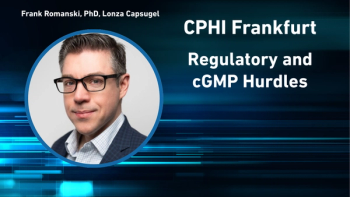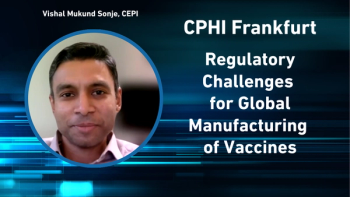
Pharmaceutical Technology Europe
- Pharmaceutical Technology Europe-05-01-2003
- Volume 15
- Issue 5
The Death of the Drug Dossier
For nearly 40 years, drug dossiers have supported the quality, safety and risk/benefits of medicinal products. However, electronic technological advances mean that the dossier will soon be a thing of the past - being replaced by e-documents that can be reviewed and approved online by regulators, under the scrutiny of patient groups and with the final blessing of purchasers, as this article examines.
For nearly 40 years, drug dossiers have supported the quality, safety and risk/benefits of medicinal products - essentially becoming the passport that every drug requires to enter the market. However, because of changing market conditions and the increasing policy of cost-containment, a good drug dossier, with its duly compiled quality, safety and efficacy reports, is no longer sufficient. There are new challenges and expectations.
Guidance and information
In the US, the provision of health care economic information (HCEI) to managed care organizations (MCOs) is common practice and is regulated by the Food and Drug Administration Modernization Act (FDAMA). In the UK, the National Institute for Clinical Excellence (NICE) has now started providing a type of "second marketing approval" by reviewing the clinical effectiveness of new and existing treatments vis-a-vis their associated costs, and providing guidance on how they should be used for patients treated by the National Health Service (NHS). There have been cases when the opinion of NICE conflicts with that of the regulator. One such example is the case of Glivec (Imatinib), a powerful anti-cancer product that was authorized by the European Medicines Evaluation Agency (EMEA), but was later, in a preliminary assessment, recommended by NICE only for patients in whom the disease was at an advanced stage (The Times 28/05/02).
Additionally, increasing economic pressure on budgets is introducing a new challenge - the need to show that a drug is truly novel. Hence, a drug dossier showing that a product can be manufactured in a quality manner and is relatively safe when compared with its efficacy is no longer sufficient to obtain market entry. Cost-effectiveness and being included in the formulary list are also crucial.
Generics
It is acknowledged that the expansion of tiered benefits in the US encourages patients to use generic products or innovative drugs that are on the formulary list. With growing patient expectations in drug decision-making processes and increased reliance on postmarketing data, gaining successful feedback from patients could represent the ultimate hurdle in the race to get a product to market (Figure 1). With this in mind, it is arguable that the traditional two-way relationship between drug manufacturers and regulators is rapidly evolving, and is beginning to include patients, purchasers and non-governmental organizations such as NICE.
Figure 1: Increasing "Threshold of Innovation" -- key milestones in the US.
Patients
Patients already play a much greater role in the regulatory process than they did a decade ago. Patient pressure, for example, aided the approval of the breast cancer drug Herceptin (Trastuzumab) for the US market with unprecedented speed. With this level of increased activity, it seems likely that patient groups will also want to know how new drugs for critical illnesses are faring during development; that is, patients may want access to some, if not all, of the information companies submit as well as access to the evaluation reports that regulators prepare. This raises many questions, including the following:
- Will companies want to release sensitive information at such an early stage in the drug development process?
- Will companies try to harness demand for new drugs and unduly sway the regulators?
- Will patients, purchasers and non-governmental organizations have part-ownership of drug dossiers?
Additionally, the responsibilities of the regulatory affairs manager, as the custodian of the drug dossier, are declining. To speed up preparation, some pharmaceutical companies are compiling dossiers during drug development, instead of preparing them afterwards. They are treating the creation of regulatory documentation as an integral part of research and development (R&D) rather than a standalone activity -- a change of perception that means it is necessary to educate other Ramp;D functions accordingly. This also means a shift in the balance of the ownership of the drug dossier from the regulatory department to other R&D functions.
From local to global
Another critical change is the shift from national to global requirements. The principal instigator of this process is the International Conference on Harmonization (ICH) - a programme supported by industry and regulators in the US, the European Union (EU) and Japan, aimed at harmonizing regulatory requirements for drug registration in the three regions.
Since its establishment in 1990, ICH has produced numerous guidelines on drug development. Some of these initiatives have established critical steps towards global development, such as the guideline on the "acceptability of foreign clinical data," which has drastically reduced the number of Phase III studies necessary to register a drug in different countries, and recently, the development of the common technical document (CTD), a set of requirements for harmonizing the structure of the drug dossier.
The CTD promises to deliver substantial benefits, and whereas the CTD and the ICH guidelines on drug development do not cover everything, they have certainly provided a good starting point for the harmonization of dossier content. By 1 July 2003, the CTD will be mandatory in the EU and Japan, and will be highly recommended in the US.
For decades, pharmaceutical companies have been forced to prepare national registration dossiers; they will now be able to prepare one dossier (with the exception of a few documents that will still need to be tailored to different regions). Unfortunately, the level of detail required is hampering the people who work in regulatory affairs - most companies have put more effort into identifying which document goes under which specific sub-heading in the CTD structure than working out how to knit multiple local units into a single multinational regulatory affairs department and secure the advantages of globalization.
Establishing a multinational department is no small task. Developing global processes and ensuring that they are applied consistently is difficult and the transition from multiple local submissions to a single global submission also has considerable staffing implications.
Electronic formats
In addition to the change from local to global standards, another major shift in regulatory affairs is moving from paper to electronic documents. Preparation of the drug registration dossier is a time-consuming activity for a regulatory department and when the deadline to submit a dossier approaches, everything else in the department often comes to a standstill.
However, these issues may soon be a thing of the past. Much of the effort devoted to preparing the dossier goes on form rather than content, but with the development of extended mark-up language (XML) - a computer language that enables the transfer of data from one use to another - old paper dossiers are being superseded by electronic documents that are being virtually published.
Regulators. The US Food and Drug Administration (FDA) is already accepting electronic submissions; however, the situation in Europe varies from one country to another because most European regulators do not yet officially accept electronic submissions. Although some agencies are willing to receive electronic dossiers accompanied by paper copies, others are prepared to accept submissions that are partly electronic and partly paper-based. Fortunately, many of these inconsistencies will soon be eliminated. The electronic common technical document (eCTD), another ICH initiative aimed at defining global standards for electronic submissions, has recently been finalized and the different national and regional authorities will be able to implement it in their own countries.
Challenges. Switching to an electronic format also presents some considerable challenges. Primarily, pharmaceutical companies will have to manage a vast amount of digital documentation and will, therefore, need new electronic document management systems, processes and working procedures. This in turn raises other issues. Paper is a durable medium, but information technology (IT) is constantly evolving, and some of the programs currently used to create and store documents may soon become obsolete. The challenge is to ensure that data generated today will still be accessible in the future.
Personnel. Moving to electronic documents is not just about investing a substantial amount of resources in IT, but also about change management. The production of electronic rather than paper dossiers may require personnel changes, such as the need to recruit regulatory staff with very different skills. Just how far should companies go in this respect? Should they appoint regulatory affairs managers who are computing experts rather than scientists with a background in chemistry or pharmacology? Should they train all their regulatory personnel in the art of electronic archiving and publishing? Although it is important to have IT skills, training every regulatory professional in the company to compile and submit electronic dossiers is not the best use of resources.
In large pharmaceutical companies (some of which have already established operational teams for electronic submissions) it may be better to establish a regulatory operations department to service the technological needs of the regulatory affairs personnel. Many mid-sized or smaller companies that are unable to afford such a division of labour may, therefore, want to explore other routes, such as outsourcing the technological functions to a specialist. Large contract research organizations (CROs) have long provided regulatory services, including dossier compilation, and a number of IT companies now provide equivalent services on an electronic basis.
Outsourcing. The increasing use of outsourcing in the pharmaceutical industry shows just how rapidly such specialist providers can grow. According to clinical trials information service CenterWatch (Boston, Massachusetts, USA), the global CRO market has increased by approximately 25% per annum during the last 3-5 years - and top-line growth rates at some CROs have been as high as 45% per annum.1 It is not difficult to envisage the introduction of the eCTD stimulating a similar expansion in contract regulatory affairs services - although whether it is CROs or IT vendors that will dominate the market remains to be seen.
Continuous reviews
Not only is the traditional drug dossier disappearing, but the very concept of regulatory approval may also be changing. The traditional one-off endorsement will give way to a continuous process in which the right to market a drug is granted and reconfirmed subject to regular reviews of its safety, efficacy and cost-effectiveness, and with new stakeholders also having their say. This may see products coming onto the market before the completion of Phase III trials, but at the same time these products will be subject to frequent re-evaluation during the drug's lifetime. This could be much more demanding than the current 5 year renewal of marketing authorizations and pharmacovigilance requirements used in some countries because it will involve new players and new criteria.
European Union. The EU plans to introduce conditional marketing authorizations, which would be valid for a year "in particular cases when there is a specific and identified patient need" and where there is "sufficient, but perhaps not definitive scientific data."2 This EU initiative may help the industry recoup R&D investments quicker while offering faster access to treatment for patients with critical illnesses.
United States. In the US, the concept of rolling submissions is not new and FDA has recently expressed the intention of piloting "continuous marketing applications" by accepting "presubmission of one or more reviewable units of the application in advance of the submission of the complete new drug application (NDA)/biologic license application (BLA),"3 as part of the goals of the Prescription Drug User Fees Application (PDUFA III). This ongoing drug approval process is also justified by the increasing attention to drug safety. The recent increase in drug withdrawals has demonstrated that premarketing studies are often not sufficient to identify all possible drug safety issues, and many problems only become evident when the product is marketed and used by an extensive number of patients.4
The future
Ongoing drug approvals will be supported by the growing power of groups such as purchasers and patient associations. Regular reviews of drug cost-effectiveness and feedback on the impact of drugs on the quality of life from patients could become part of the continual assessment process.
With the introduction of initiatives, such as conditional marketing authorization and the growing emphasis on postmarketing studies, the boundary between the laboratory and real life is beginning to blur. The traditional dossier may disappear altogether, to be replaced by a "living drug story" - a continuous record that includes postmarketing studies, adverse event reports and feedback from patients.
These changes will bring substantial benefits. Earlier approval would accelerate patient access to drugs for diseases that have previously resisted treatment. It would also enable pharmaceutical companies to recoup their investment more rapidly; while the continual renewal of the drug passport will ensure that the product is still fit to be on the market.
References
1. Pharmaceutical R&D Statistical Sourcebook (Parexel International Corp., Waltham, Massachusetts, USA, 2001) p 26.
2. Erkki Liikanen, "Commission's Proposal to Review EU Pharmaceutical Legislation," transcript of speech/01/354, Brussels, Belgium, 18 July 2001 (
3. PDUFA Reathorization Performance Goals and Procedures (
4. C. Hart "Monitoring Medications in the Marketplace," Mod. Drug Disc., 3(5), 40-41 and 43-44 (2000).
Articles in this issue
over 22 years ago
The New Tabletting Facilityover 22 years ago
Nobler in the Mind? The Dilemma for European Researchover 22 years ago
Drug safety in the limelightover 22 years ago
Qualification of a Chromotographic Columnover 22 years ago
21 CFR Part 11: The New Draft GuidanceNewsletter
Get the essential updates shaping the future of pharma manufacturing and compliance—subscribe today to Pharmaceutical Technology and never miss a breakthrough.





